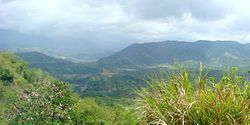Pantabangan, Nueva Ecija
| Pantabangan | ||
|---|---|---|
| Municipality | ||
 |
||
|
||
 Map of Nueva Ecija showing the location of Pantabangan |
||
| Location within the Philippines | ||
| Coordinates: 15°49′N 121°09′E / 15.817°N 121.150°ECoordinates: 15°49′N 121°09′E / 15.817°N 121.150°E | ||
| Country | Philippines | |
| Region | Central Luzon (Region III) | |
| Province | Nueva Ecija | |
| District | 2nd District | |
| Founded | 1701 | |
| Barangays | 14 | |
| Government | ||
| • Mayor | Roberto Agdipa | |
| Area | ||
| • Total | 392.56 km2 (151.57 sq mi) | |
| Population (2010) | ||
| • Total | 27,353 | |
| • Density | 70/km2 (180/sq mi) | |
| Time zone | PST (UTC+8) | |
| ZIP code | 3124 | |
| IDD : area code | +63 (0)44 | |
| Income class | 1st class | |
Pantabangan is a first class municipality in the province of Nueva Ecija, Philippines. According to the 2010 census, it has a population of 27,353 people. This is the site of the Pantabangan Dam and Lake.
Located in the northern part of Nueva Ecija, Pantabangan is located at the foot of Mt. Mabilog below Mt. Dalimanok which are found between Sierra Madre and Caraballo Mountain ranges. It is home to the Pantabangan–Carranglan Watershed Forest Reserve.
Pantabangan is politically subdivided into 14 barangays.
The place was discovered on November 30, 1645, by Fr. Juan Alonzo de Abarca, an Augustinian priest who with the 29th Spanish mission in the Philippines.
The village grew into a settlement and was officially included in the map of the Philippines in 1747. In 1900, Pantabangan formally became a town.
In early 16th to 17th centuries, the “Id-dules” (Aetas or Baluga) and Egongots (Ilongots) tribe inhabited the southern Sierra Madre and Caraballo Mountains. Based on Mr. Elito V. Circa, a folk visual artist and a writer who wrote most of the Pantabangan-Egongot arts and culture and interviewed some of the Egongot chieftains from Aurora province. He discovered that Pantabangan (Pantabanganan in early 18th century) came from the root Ilongot word "Sabangan or Sabanganan" that means "junction of water streams". It was learned that most of the places in Central Luzon were derived from Ilongot word like Caanaoan, Puncan, Cadanglaan (now Carranglan), Kabaritan (Now San Jose City) and others. Bungamong (Bongabon) and Cadanglaan was formerly sitio of Pantabangan and Kabaritan also part of Pantabangan.
...
Wikipedia


